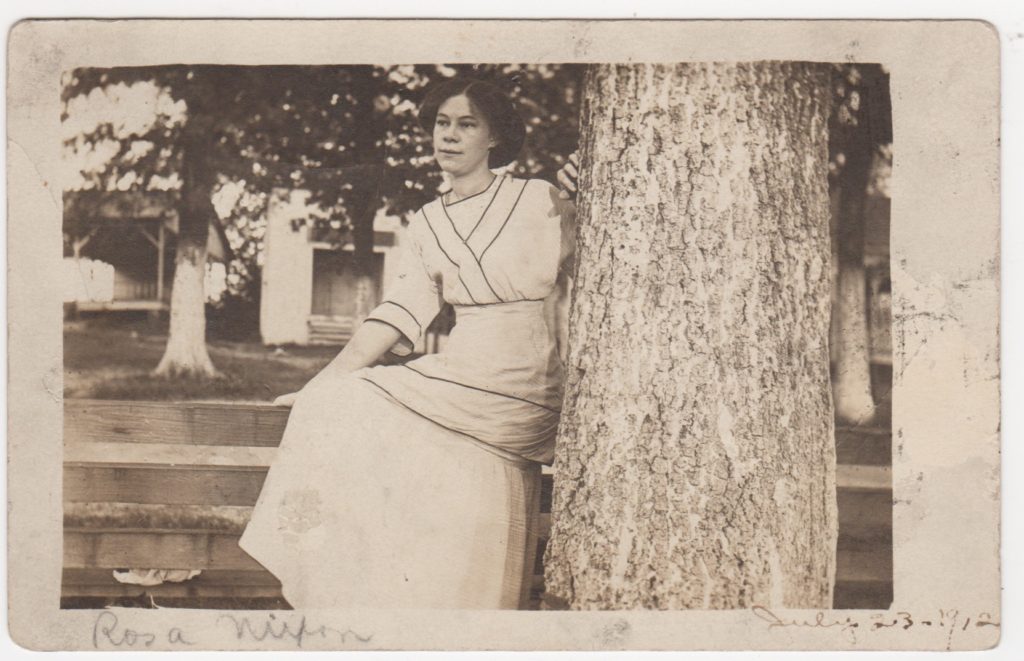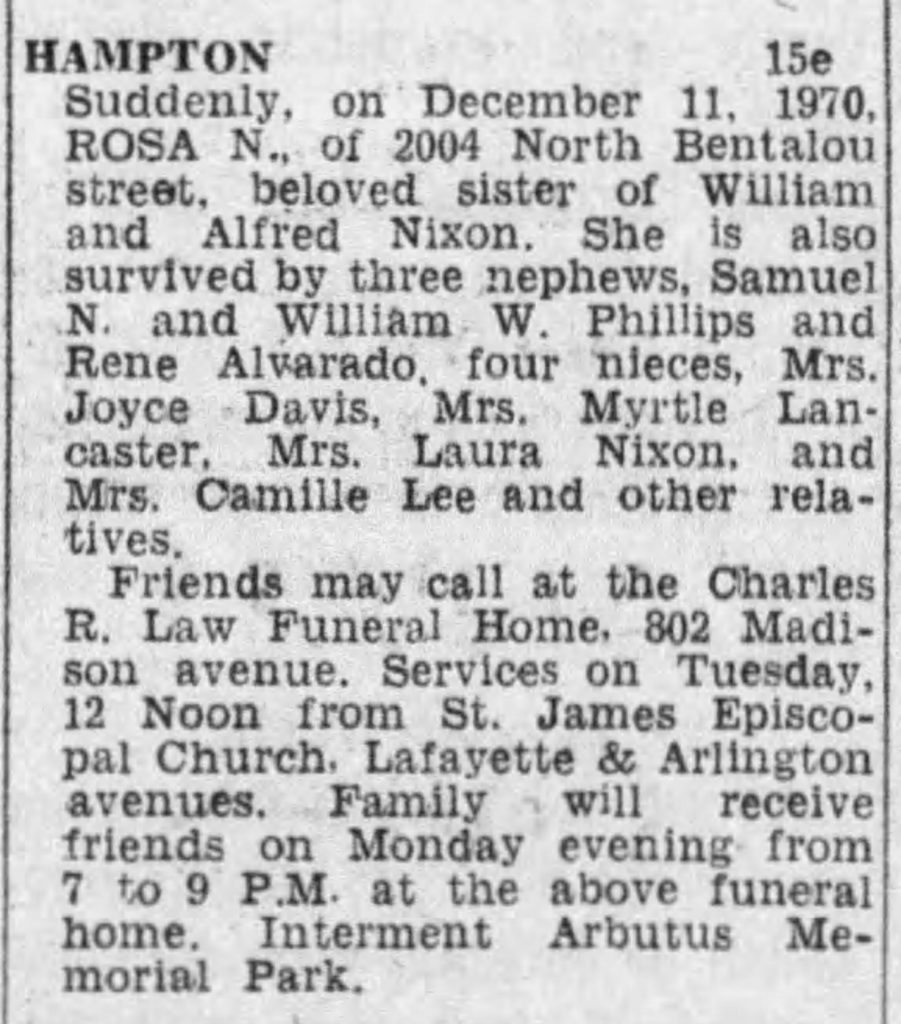This year I am going through an alphabet of news items taken from The Emancipator newspaper, published between 1917 and 1920 in Montgomery, Alabama. Most are about my grandparent’s circle of friends. All of the news items were found on Newspapers.com. Each item is transcribed directly below the clipping. Click on any image to enlarge.
___________
Rosa Nixon was a friend of my grandparents. One of her sisters married into the same family that one of my grandmother’s first cousins married into. She graduated in the class of 1906 at State Normal School for Negroes, as did Mattie Graham.
Miss Rosa Nixon Accepts Position In Baltimore
Montgomery, Ala., Feb. 20- Miss Rosa Nixon of this city, resigned her position as head of the Art Department of the local State Normal School on Monday of this week in order to accept a position in the Baltimore Colored High School. The resignation went into effect Tuesday, the 19th inst., and Miss Nixon will leave to take up her new work at Baltimore on Thursday morning, February 21st.
Miss Nixon is one of the leading art teachers of the race, having studied in the foremost art schools of the country. Her excellent work as a teacher, club worker and member of the local Red Cross Auxiliary in this community will be sadly missed and her host of friends here are loath to have her go to another field. Miss Nixon has been head of the Art Department in the Normal School here for several years, during which time she has enlarged and developed the department to a high standard of efficiency.
While looking through my grandmother Fannie’s photographs, I came across this picture of Rosa Nixon. I wondered who she was. On the back it says “Mershell C. Graham – Rosa. And then in my mother’s handwriting it says ‘Not related! – One of Daddy’s girls, I suppose – he didn’t marry until 1918.’“
Rosa Nixon was born into a family that started off after slavery with more advantages than most. Her grandmother Winnie Nixon, received land, livestock, furniture and money upon the death of her former slave master, William Owen Nixon of Lowndes County, Alabama in 1868. In 1870 she had real estate valued at $4,000 and personal property valued at $1,000. All except the youngest two of her nine children were attending school. One of them was Rosa’s father, Alfred Nixon.
Rosa Nixon was born in September, 1889 in Montgomery, Alabama, the second of the four daughters of Alfred and Hattie (Clayton) Nixon. Hattie and her youngest baby girl, Zenobia died within a few months of each other in 1895. Zenobia was a year old. Hattie was 25.
Alfred Nixon worked as a porter and then as a bar tender. He remarried in 1901. He and his second wife, Mattie Coleman had three children together. One died. Two boys, Alfred Floyd and William O. Nixon were born in 1902 and 1904. Rosa graduated from Normal School in 1907. My grandmother Fannie and all of her cousins also graduated from this school, which went from first grade through high school.
Receive Diplomas
Graduation At Normal School For Negroes
Program Includes Addresses by Tom Benjamin, Music and Addresses by Principal Paterson, and Several Friend of School
Twenty-four students, seventeen girls and seven boys received diplomas yesterday morning from the State Normal School for negroes (sic.). The graduating exercises included addresses by ten of the students, vocal and instrumental music, and remarks by Principal W.H. Paterson and friends of the school. The dominant note in each of the speeches made to the students and patrons of the school was that the negroes must educate their children, that they must supplement the work being done, by the State and that they must throw safeguards around the morals of their children as well as giving them assistance in securing knowledge.
Incidentally, the municipality of Montgomery was criticized for its failure to give negro children equal opportunity with white children in the schools and the lack of school room for negro children in this city was pointed out.
The closing exercises were held in the chapel, which is on the second floor of the main building. The twenty-four graduates formed a double semi-circle on the stage, which was decorated in the colors of the school, and the class of 1907. Sitting with the class on the stage were many of the negro preachers of Montgomery, including Bishop J. W. Alstork.
Simplicity marked the dress of the girls in the graduating class. They wore calico dresses. Frequent allusion was made to this simplicity of dress by Principal Paterson and the other speakers. The Principal said he had promised the girl students that he would provide the cloth if the girls would make the dresses and wear calico. they had readily consented and this simplicity of dress, he said, would be adhered to in the future. It was done, he said, in the interest of the poor parents of many of the student.
The graduating class consisted of Frederick D. Adair, Edna T. Barnett, Maris H. Brown. Dora D. Beverly, Melissa B. Culpepper, Mattie E. Graham, James B. Hatcher, Nora J. Holly, Olivia C. Hunter, Helen E. Jones, Adam J. Joseph, Queenie V. Lee, Gertrude R. Lucas, Rose H. Nixon, Alfred A. Poole, Sadie M. Richardson, Olivia A. Royal, Mary L. Sawyer, Rosa L. Shaw, Emmaline L. Simpson, Cornelius S. Sampson, Henry J. Todd, Charles D. Watkins, Ellen A. Wimbs.
According to the custom of the school, the ten students making the highest marks, prepared essays. Three essays were delivered without reference to manuscripts. They gave evidence of careful preparation and some of them were delivered with fine effect. None but members of the graduating class were on the program, which was as follows.
Invocation.
Piano Duet, “Jeunesse Doree” – (Smith)-Helen Jones and Rosa Nixon.
Salutatory and Oration, “The Christian Ministry” – James E. Hatcher
Oration, “Nature & Mysteries” – Emmaline Simpson.
Vocal Quartet, “Over the Hills at Break of Day” – (Geibel) – Olivia Royal, James S. Hatcher, Sadie Brown, Alfred Poole.
Oration, “The Conditions and Needs of Women Wage- Earners” – Hosea L. Shaw.
Essay, “The Leisure Class” – Olivia A. Royal.
Piano Solo. “Fanfare” – (Ascher) – Nora Holley
Oration, “The Genius of Japanese Civilization” – Olivia C. Hunter
Essay, “The Most Lasting Monuments” – Sadie B. Brown.
Vocal Duet, “When Gathering Clouds” – (Shuey) Sadie B. Brown, James E. Hatcher
Oration, “Has the Negro Race Made Any Real Progress?” – Charles D. Watkins.
Oration, “Women in History” – Helen E. Jones.
Piano due, “La Baladine” – (Lysberg) – Mary Sawyer and Dora Beverly.
Oration, “The Duty of the Hour” Rosa Nixon
Essay, “The Results of Fraternities” Harry J. Todd
Sojourner Truth Club Essay – Helen N. Jones
Valedictory. “Through Trials to Triumphs’ – Dora Beverly.
Presentation of Diplomas
“My Old Kentucky Home” – By the Class
Benediction
Principal Paterson announced that Helen Jones had won the prize annually offered by the Sojourner Truth Club, an organization of negro women, for the best essay on achievements by the race. The Jones girl then went forward and read the essay written on “Self help.” It was also announced that Wilson Walker, Sadie Castle, Effie May Todd and Lena Davenport had won prizes for garden work.
At the conclusion of the graduating exercises, brief addresses were delivered by Bishop Alstork, Nathan Alexander and other friends of the school.
In concluding the exercises, Principal Paterson said the school now owned property valued at $30,000, and that plans were making for an extension of its work another year.
During the year just closed, the school enrolled 1,055 pupils.
__________________
Rosa’s father died in 1908. There are no death certificates in Alabama at that time but I found a notice of his death and funeral in the local Montgomery paper.
Funeral Notice
“The friends and acquaintances of Mr. and Mrs. Alfred F. Nixon, are respectfully invited to attend the funeral of the former, from the Old Ship Church at 8 p.m., Thursday, Oct. 1st, 1908.”
Alfred Nixon owned his house free of mortgage when he died in 1908. In 1910, Rosa and her older sister Eugenia were both teaching. The three youngest children were all attending school. Her step-mother was not working outside of the home. The step-mother’s mother also shared the home.
Rosa taught at art at State normal School. She was active in community and social activities, heading the Red Cross Drive in 1917. In 1918 the art department, under Rosa Nixon’s supervision, bought a potters wheel. The students were all excited and looking forward to making a plate each.
We have now reached the article that started this post. Rosa Nixon, now 28 years old and the head of the Art Department of State Normal School, is headed to Baltimore, Maryland to head the Art Department at the Colored High School there. She boarded with several other teachers. That summer she attended art classes at Columbia University in New York City.
In 1921 Rosa was appointed to head the Art Department of Dunbar High School in Washington DC. Over the years she organized trips to museums, art galleries and other places of interest to her art students. She also continued to expand her own skills with workshops and classes.
In 1929 Rosa married John Henry Hampton, a postal worker. She continued to teach at Dunbar although she and her husband maintained a house in Baltimore. In 1940, Rosa’s widowed older sister, Eugenia and her two sons, both young men, were living in a separate flat in Rosa and her husband’s house. In 1951, after 30 years of service, the school board retired her. It doesn’t sound like she went willingly. She was 61 years old. Rosa’s husband died in 1961. One of her nephews was living with her when Rosa died suddenly at the age of 81, on December 11, 1970.
Hampton
Suddenly, on December 11, 1970. Rosa N., of 2004 North Bentalou Street, beloved sister of William and Alfred Nixon. She is also survived by three nephews, Samuel N. and William W. Phillips and Rene Alvarado, four nieces, Mrs. Joyce Davis, Mrs. Myrtle Lancaster, Mrs Laura Nixon, and Mrs. Camille Lee and other relatives.
Friends may call at the Charles R. Law Funeral Home, 802 Madison Avenue. Services on Tuesday, 12 Noon from St. James Episcopal Church, Lafayette & Arlington Avenues. Family will receive friends on Monday evening from 7 to 9 P.M. at the above funeral home. Interment Arbutus Memorial Park.
_________________
I found this information on Ancestry.com in Census Records, Directories, Death Records and Military Records. The news item was found on Newspapers.com and Genealogy Bank. The photograph is from my personal collection.





Really like that the principal allowed calico dresses for the graduation. Love Rosa’s dress in the photo too!
I liked that too. I wondered why he didn’t choose Muslin though, which would have made white dresses and been cheap too. Maybe he thought calico would get more use after graduation.
She must have been a really good teacher not only teaching techniques of various art forms but also exposing students to great art housed in museums. I found the story of her grandmother’s inheritance to be really interesting. Do you suppose the slave master was also her father?
I thought the slave holder was her children’s father. I noticed that Alfred named one of his sons after him too.
She sounded like an engaged and interested teacher for sure. I wish I had found some of her drawings online.
I thought the 1912 photograph of her was very pretty and surprisingly informally posed. The dress is delightful.
There were quite a few informal photos in my grandparents collection. Posed, but not formal.
What a shame we don’t have her graduation essay, or samples of her art work. She sounds like such an accomplished woman!